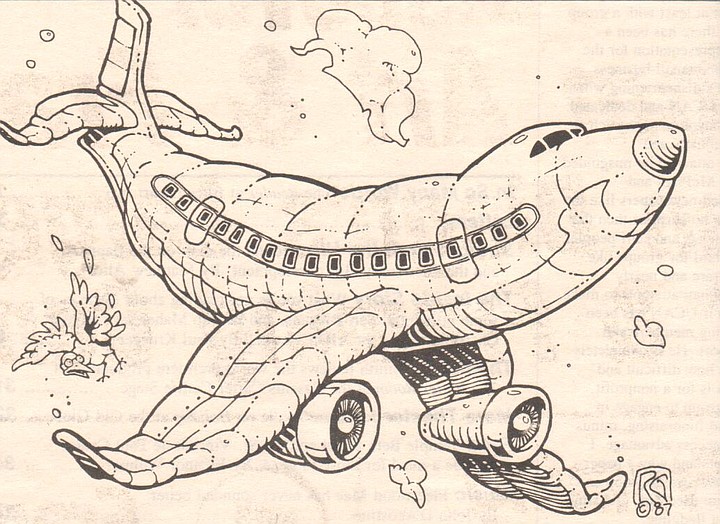 Facebook
Facebook
 X
X
 Instagram
Instagram
 TikTok
TikTok
 Youtube
Youtube

Dear Matthew Alice:
Has anyone ever built a heavier-than-air device that flies by flapping its wings, either manned or remote control? If it hasn't been done, is it theoretically possible?
Bruce M. Binder, Pacific Beach
Bruce, I'll bet if you lived back in the 1800s (or in the 1300s, for that matter) you would have been among the hoardes of dreamers and schemers leaping off towers and mountains and tree tops flapping your can't-fail, homemade wing contraption, frantically trying to fly. Local aviator John Montgomery experimented with them on Otay Mesa before abandoning the idea to concentrate on gliders. I'll save you a little trouble of trying to invent the impossible. No one has ever devised a successful man-powered flapping machine that could lift someone off the ground and achieve level flight. It's been estimated that a person would have to have pectoral muscles as big around as the average pillow to generate enough force to fly, even with the most cleverly designed wings.
But ornithopters, as bird-imitating machines are called, have been flown successfully. About a hundred years ago, an Australian inventor built several small ornithopters that were powered by tiny, alcohol-burning steam engines. They were only about two feet long. but they did fly successfully by flapping their wings. And even today, toy ornithopters powered by rubber bands can be found occasionally in stores.
But the idea of human-powered flight has continued to fascinate people, and in the last twenty years there has been a resurgence of interest. One of the most successful experiments is Project Daedalus at MIT. They've developed several fixed-wing planes in which the pilot peddles a bicycle-like device that turns the propeller. They're now working on a human-powered plane that they plan to fly this spring the sixty-nine miles from Crete to the mainland of Greece in a duplication of the mythological flight of Daedalus and Icarus, probably the most famous of the ornithopter pilots.


Dear Matthew Alice:
Has anyone ever built a heavier-than-air device that flies by flapping its wings, either manned or remote control? If it hasn't been done, is it theoretically possible?
Bruce M. Binder, Pacific Beach
Bruce, I'll bet if you lived back in the 1800s (or in the 1300s, for that matter) you would have been among the hoardes of dreamers and schemers leaping off towers and mountains and tree tops flapping your can't-fail, homemade wing contraption, frantically trying to fly. Local aviator John Montgomery experimented with them on Otay Mesa before abandoning the idea to concentrate on gliders. I'll save you a little trouble of trying to invent the impossible. No one has ever devised a successful man-powered flapping machine that could lift someone off the ground and achieve level flight. It's been estimated that a person would have to have pectoral muscles as big around as the average pillow to generate enough force to fly, even with the most cleverly designed wings.
But ornithopters, as bird-imitating machines are called, have been flown successfully. About a hundred years ago, an Australian inventor built several small ornithopters that were powered by tiny, alcohol-burning steam engines. They were only about two feet long. but they did fly successfully by flapping their wings. And even today, toy ornithopters powered by rubber bands can be found occasionally in stores.
But the idea of human-powered flight has continued to fascinate people, and in the last twenty years there has been a resurgence of interest. One of the most successful experiments is Project Daedalus at MIT. They've developed several fixed-wing planes in which the pilot peddles a bicycle-like device that turns the propeller. They're now working on a human-powered plane that they plan to fly this spring the sixty-nine miles from Crete to the mainland of Greece in a duplication of the mythological flight of Daedalus and Icarus, probably the most famous of the ornithopter pilots.
Comments